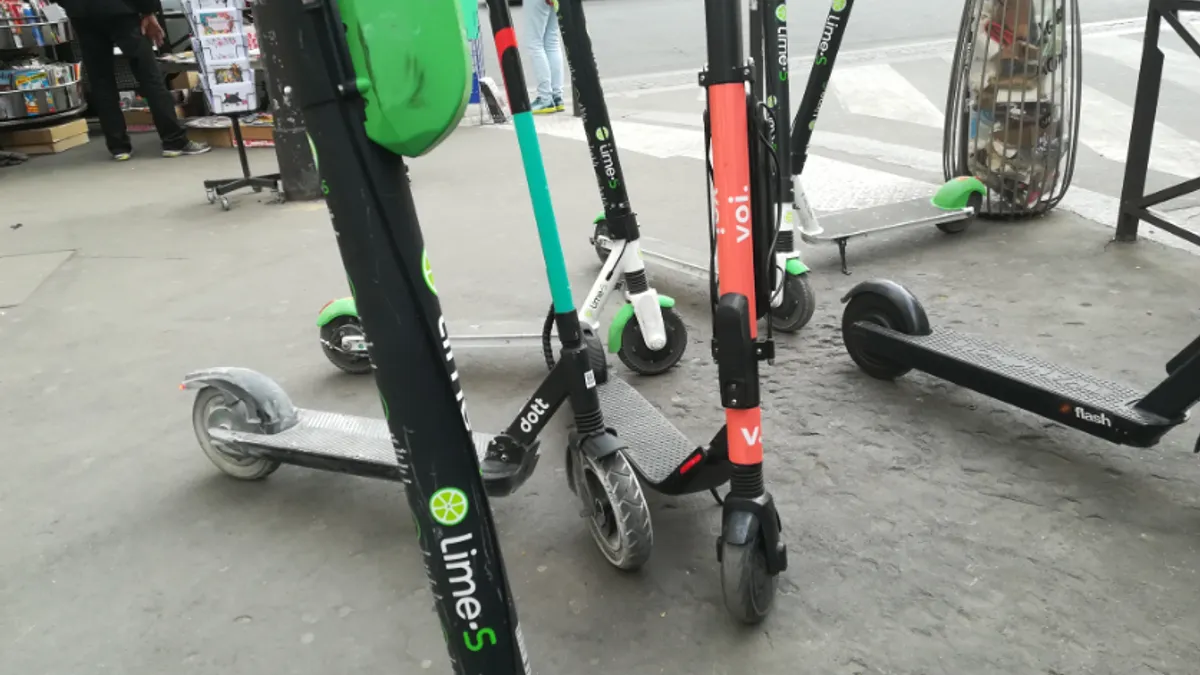CFO in the Know is an editorial series examining the roles CFOs play across a variety of industries. You can find the entire series here.
Dockless scooters, like ride-sharing and autonomous vehicles, are rapidly changing urban mobility, but the viability of their business model is vexing investors and analysts. Ted Tobiason, CFO of Lime, the largest player in the dockless scooter category with 120,000 scooters deployed in 120 cities in 30 countries and more than $400 million in annual revenue, says his company is already profitable in many of the markets it’s in.
“We are ... on the path to profitability sooner than expected,” he told CFO Dive in an email. “We do not need to sacrifice profitability to grow rapidly.”
But turning a profit in individual markets is different from having a profitable business on a net basis. Analysts say Lime, along with its competition, is unlikely to become sustainably profitable until it lowers the scooters' costs and, by extension, its operations costs.
The dockless scooter business model "is being undermined by the longevity of the scooters,” Michael Ramsey, a transportation analyst with Gartner, told CFO Dive. “It’s extremely challenging for them to break even if their scooters are going out of service so fast. Even at a high volume discount, you’re talking about a minimum of about $350 a scooter. And your average fare on a scooter ride is about $5. You start to do the math.”
Scooter companies haven’t released definitive data on how long their scooters last, but an analysis conducted last year by business news publication Quartz estimated 28.8 days on average for scooters owned by Bird, Lime’s biggest competitor. That was based on the tracking of scooters by serial number in a single market, Louisville, Kentucky, and comes with caveats.
Earlier this year Bird said it’s on its third generation of scooter and it believes the useful life is closer to a year. Lime says its scooters last an average of 18 months or more.
"At Lime, we are always innovating on our products," said Tobiason. "We are investing in extending lifespan of our products while lowering per-unit costs, including increasing parts repair and reuse for an increasingly sustainable product. Our scooter lifespan is increasing with each new e-scooter generation and our Gen 3 lasts far longer than any scooter model that has come before it."
Lime is a private company and publicly available financial information is limited, but it’s expected to lose $300 million on $420 million in revenue this year, according to The Information, a deep-dive technology journal, largely because of depreciation on its scooters and the cost of maintaining, storing, and moving them.
Just through July, the company reportedly burned through $200 million and is working to secure a new lead investor to help it lift its valuation above its current $2.4 billion.
Should it secure the new investment, that would go on top of roughly $800 million in capital the company has raised since it launched in 2017. Its early investors include Alphabet venture capital affiliate GV, Andressen Horowitz, Uber and Singaporean sovereign wealth fund GIC.
Tobiason calls the market opportunity for Lime huge. “We are laser-focused on growing our business in a smart and sustainable way with rider acquisition and brand loyalty.” he said. “This year we've launched partnerships like N26, group ride features and more.”
N26 is a mobile banking company. Under its Lime partnership, riders who add the company’s banking app to their phone and use it to pay for their scooter rides get half off the cost of rides in 11 European countries.
Cost challenges
Costs to ride a dockless scooter vary by company and market. Lime charges $1 to unlock the scooter and 25 cents per minute of ride, using Spokane, Washington, as a representative market. Its main competitor, Bird, valued at a reported $2.5 billion and operating in 120 cities, charges $1 to unlock the scooter and 29 cents per minute of ride, using Indianapolis as a representative market. At the rate these two companies charge, a 10-minute ride would generate between $3.70 and $3.90 in income.
In its analysis, Quartz looked at the economics of Bird in Louisville and concluded, based on data from last year, the company has a steep path forward.
As a condition of operating in the city, Bird agreed to provide Louisville per-ride data. Based on that data and an analysis conducted by The Information, the company appeared to sustain a loss of $293 over the life of each scooter it operated. Here’s how the number was derived, assuming 163.2 miles over 92 trips per scooter at the estimated 28.8-day lifespan.
Revenue:
- 3.49 rides per scooter per day on average.
- 18 minutes per trip on average, generating $3.70 in revenue, assuming 15 cents per mile charged in Louisville last year.
- $12.91 in revenue per day per scooter.
Costs:
- $1.72 per ride for charging.
- 51 cents per ride, on average, for repairs.
- 41 cents per ride in credit card fees.
- 6 cents per ride for customer support.
- 5 cents per ride for insurance.
- $2.75 per ride on average total.
Broader operational costs:
- $3,000 for probationary and permanent city operating licenses.
- $100 for designated group scooter parking.
- $50 annual fee per scooter.
- $1 per day fee per scooter.
Here’s how the math comes out:
If each scooter generates $3.70 in revenue per ride, the company is left with 95 cents per ride after deducting costs for charging and repairs, credit card fees, customer support and insurance. Multiplying that by 3.49 rides per day generates $3.32 in net revenue per scooter per day. Subtracting the city’s $1 daily fee leaves $2.32. Assuming 28.8 days in average lifespan, the company earns $67 in revenue over the life of the scooter. Then, subtracting $360 per scooter (a generous estimate; it was reportedly paying closer to $550 per scooter last year but is aiming for $360), it loses $293 per scooter, not counting fixed overhead operational costs like the $3,000 in licensing fees, $50 per-scooter annual fee, and $100 designated parking area fee.
Reason for optimism
Notwithstanding the hurdle to profitability, the business continues to hold promise. It’s just a matter of getting the per-scooter cost down, extending their life, and realizing more operational cost efficiencies, say analysts. It's a safe bet the companies have made progress on that since the Quartz analysis was done.
“These could very well be solidly profitable businesses,” Tom White, an analyst with D.A. Davidson, told CFO Dive. “It’s not hard seeing these things paying for themselves in a reasonably short time frame. So, on that basis, the unit economics would seem to be somewhat attractive on a gross margin basis.”
“Once you hit break-even on the capital investments, you just have the limited cloud infrastructure overhead,” said Ramsey of Gartner. “It’s like this struggle to cover the cost of capital, which is really about making these scooters last a while and getting their use up. So, that’s the main challenge.”
Will Uber and Lyft drive efficiencies?
In addition to many smaller private competing brands, including Spin, Bolt and Sherpa, Lime and Bird face new competition from the two biggest ridesharing players in the U.S.: Lyft and Uber.
Lyft entered Denver last year in September, the first of many markets, and Uber, one of Lime’s investors and an early supplier of scooters, a short time later expanded its Jump bikeshare brand to include dockless scooters. Both have since pulled out of several markets already crowded with competition, but they remain in the business.
"Scooters are a way to make daily trips more fun and encourage multimodal commuting," Caroline Samponaro, a Lyft bike and scooter executive, told CNN last year.
“We want to be the Amazon of transportation,” Uber’s CEO, Dara Khosrowshahi, also said last year.
The companies are investing heavily in the sector. Lyft spent $68.7 million on equipment after its scooter rollout and another $25.4 million earlier this year, while Uber is said to have invested $558 million, according to Fortune.
With these two publicly traded companies in the mix, the sector is bound to get more scrutiny, but so far this aspect of their business is too small to get called out separately in their financials.
“I’m not sure the institutional investor community has necessarily done a ton of work yet to really understand these businesses,” said White. “At the size [Lyft and Uber] are at now, even though they aren’t making money, their scooter business isn’t consequential to their overall consolidated financials. They’re just not big enough yet to move the needle.”
2020, the third year of the scooter revolution, might be a different story, kicking off consolidation, McKinsey analyst Kersten Heineke believes.
“When we get to the third season, which is next year in the U.S., we’ll begin to see which business models are profitable and surviving,” he said. “It will be a market of five-to-seven players per region or country.”
This series is brought to you by BMO Financial Group, one of the largest diversified financial services providers in North America and leading in commercial, corporate and investment banking. To learn more about their financial expertise, visit their website here. BMO has no influence over CFO Dive's coverage.






















